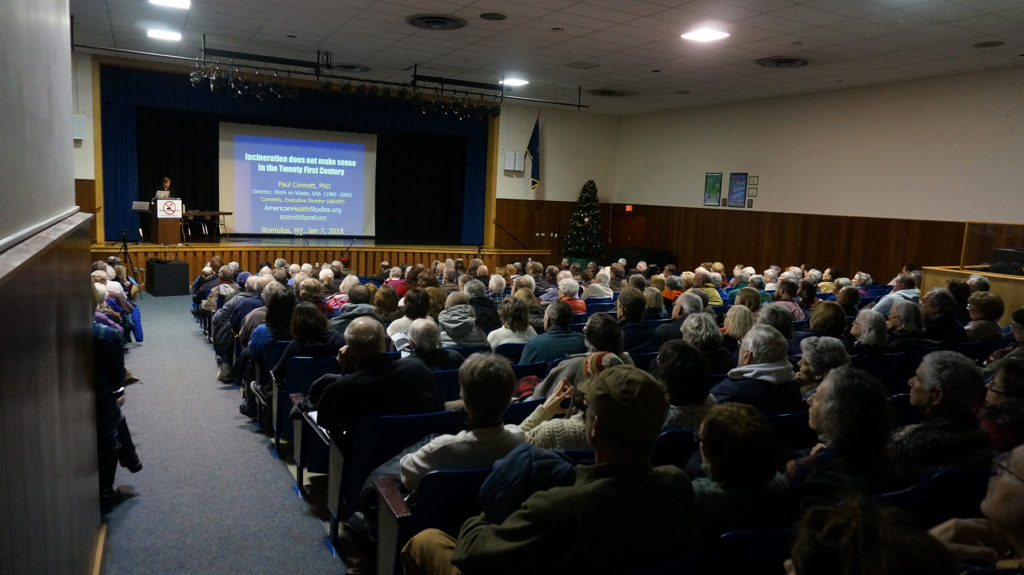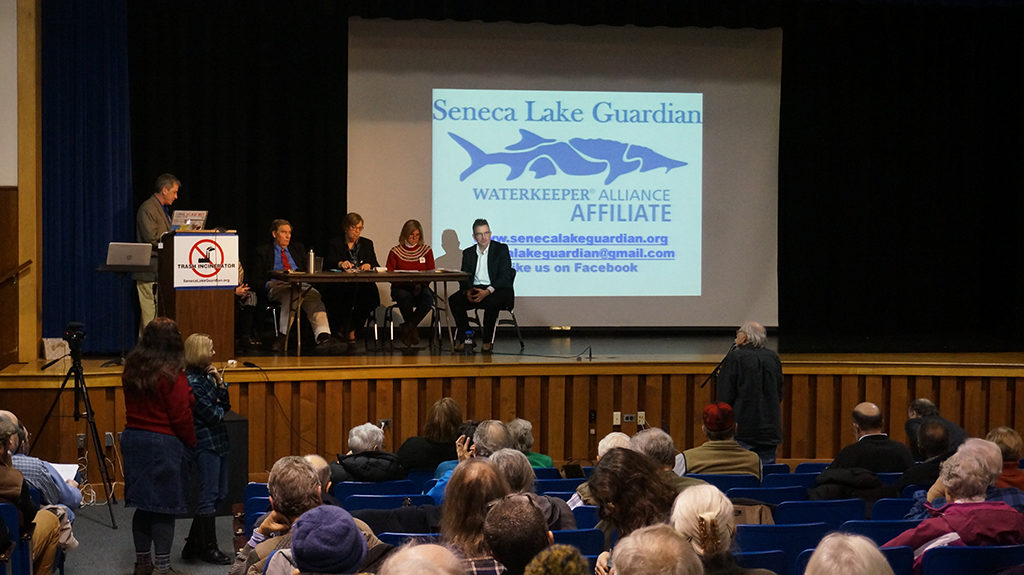Firestorm in the Finger Lakes
by Len Geller –
A $365 million trash-burning incinerator with a 260-foot smokestack capable of burning up to 2,640 tons of garbage a day in the heart of the Finger Lakes? It sounds absurd, almost surreal, but in fact that’s what Circular enerG LLC, a newly formed company with no track record or experience in solid-waste management, is proposing to build on the former Seneca Army Depot in the town of Romulus in Seneca County.

When fully operational, the trash incinerator would be the largest in New York State, burning between 1350 and 2640 tons of garbage a day, with 50-75 full-time employees, and producing up to 50 megawatts of power in the form of electricity. It would need to withdraw about 445,000 gallons of water from Seneca Lake each day to cool the incinerator machinery before returning the heated water to the lake. The trash would come from all over the state including New York City, first just by truck and then by rail and truck. According to Circular enerG, this would require as many as 176 waste-hauling truck loads and 62 other truck loads carrying ash, scrap metals, and other materials per day, but once the rail service is up and running, this traffic would be greatly reduced. By how much is unclear.
Who is Circular energy, LLC? The company’s incorporation papers do not list owners, directors, or investors, and when Alan Knauf, the company’s lawyer and representative, was asked this question, he declined to answer. What we do know is that the company was formed in January of 2017. It shares a Rochester address with Seneca Depot LLC, Flaum Management, and Top Capital of New York. Seneca Depot LLC owns the 48-acre parcel of land at the former Seneca Army Depot on which the proposed incinerator would be built, and David Flaum, a Rochester developer and partner in Seneca Depot LLC, is cited by Knauf as the seller of the property. According to Knauf, Top Capital is “affiliated with” but does not own Circular enerG. Although Knauf has declined to specify the nature of this affiliation, it is clear that Top Capital is the likely source of Circular enerG’s funding for the project.
Who is Top Capital of New York, LLC? According to their sparse website, Top Capital is a Rochester based “capital investment firm and business development private equity company” involved in funding businesses ranging from manufacturing and commercial real estate to the hospitality industry and senior living. Founder and Chairman Zheng “Gene” Zhou, originally from China but now a naturalized citizen, said in a July 2017 press release that Top Capital plans to invest “more than $200 million in a ‘circular economy’ project that will create energy from trash.” Who are Zhou’s investors? We don’t know, but in a January 2016 press release, Top Capital announced a partnership with CEA International, a consulting firm specializing in immigration and EB-5 applications for foreign investment. Created by Congress in 1990, the federal EB-5 program allows foreigners to obtain visas leading to permanent residency in the U.S. in exchange for investing at least $1 million (or half a million under some circumstances) in business projects that are viable and create U.S. jobs. Nearly 90% of foreign investors under the EB-5 program are from China. In the press release cited above, Louis Giardino, President and CEO of CEA International, said that EB-5 investments provided critical financial assistance in developing Top Capital’s Senior’s Choice at Heritage Square, an upscale independent and assisted living community for seniors in Brockport, New York. When environmental blogger Peter Mantius (https://waterfrontonline.blog/) asked Alan Knauf if EB-5 investment funds would be used to finance Circular enerG’s Romulus incinerator, Knauf emphatically said no.
What are we to make of all the secrecy surrounding the project? Knauf’s unwillingness to reveal both the source of Circular enegG’s funding and what company will actually operate the trash incinerator raises a huge red flag. What we do know is that Circular enerG is obviously a front company for capital investors and corporate interests who want to remain in the shadows. When I asked Dr. Paul Connett, anti-incinerator activist and keynote speaker at the January 7 forum at the Romulus Central School, for more details about Circular enerG, he said that if it secures the necessary permits to build the incinerator, it will most likely sell the facility to Covanta, a New Jersey company that owns or operates 7 of the 10 trash burning plants in New York State. If Connett wasn’t an expert on the politics surrounding waste incineration, I would probably dismiss his remarks as pure speculation. But since he is an expert with decades of experience fighting waste incineration, his prediction has credibility.
Hoping that the Romulus Planning Board would act as the lead regulatory agency on his client’s proposal and grant it a special use permit as a “renewable energy producer”, Alan Knauf, after months of covert maneuvering (see Peter Mantius’ Water Front Blog entries of January 8th and 25th for details), submitted the proposal to the board for the first time in November 2017. On December 6 the Planning Board announced its intention to assume the lead agency role but was overruled two weeks later by the state Department of Environmental Conservation (DEC) on grounds that the proposed waste-to-energy facility would require six DEC permits and had the potential for impacts that were not primarily local. In the same letter to the Planning Board Chair, DEC Regional Permit Administrator Scott Sheeley also indicated that since Article 10 of the Public Service Law may apply in this case, Circular enerG should request such a determination from the the Department of Public Service (DPS), and if Article 10 does apply, the project would be exempt from a State Environmental Quality Review (SEQR) and instead fall under the purview of the Board on Electric Generation Siting and the Environment (Siting Board).
Once authority for the permit decision was removed from the Planning Board and taken over by the DEC and possibly the DPS, Knauf withdrew Circular enerG’s application for a special use permit on January 5, 2018. But the story does not end here. Failing to secure a special use permit on the local level, Knauf has indicated that
Circular enerG will apply to the DPS for review and approval of its proposal, and when this happens, the decision will rest with the State Siting Board.
Article 10 of the Public Service Law gives the Siting Board authority over the placement of any electricity generating facility that produces 25 megawatts or more, and Circular enerG’s proposal meets that condition. The company’s project has two phases: in the first phase, scheduled for completion in December 2021, the trash incinerator will produce slightly under 25 megawatts of electricity; in the second phase, scheduled for completion in December 2023, it will produce up to 50 megawatts of electricity.
Does this mean that local officials, citizens, and groups potentially affected by a waste-to-energy incinerator in the heart of the Finger Lakes have no say or input in the permitting decision? Has local control been taken away (some would say “usurped” or “stolen”) by the state? Absolutely not. A key provision of Article 10 requires an extensive environmental and public health impact analysis, considerations of environmental justice and public safety, and critical attention given to local laws and ordinances, all of which will play a crucial role in the board’s decision. Another provision of Article 10 provides for the appointment of two ad hoc public members to the seven-member Siting Board from the municipality (Town of Romulus) where the facility will be located. Both provisions allow for extensive local input, not just from local town and county officials but from private citizens and business and environmental groups.

The prospect of a trash-burning incinerator next to Seneca Lake has ignited a firestorm of opposition and protest across the Finger Lakes region. The Romulus Planning Board has made it clear that the project is not a producer of renewable energy and is in clear violation of the town’s zoning laws. The Romulus Town Board has declared a six-month moratorium on all projects requiring approval by the town Zoning Board of Appeals and is considering a one-year moratorium on any waste-to-energy facilities or landfill operations within the town. Hundreds of citizens have turned out to voice their opposition at Planning Board and Town Board meetings and at a forum held at the Romulus Central School auditorium on January 7. The Geneva City Council and the Ontario County Board of Supervisors have voted unanimously to support a resolution opposing the waste-to-energy project. Strong public opposition has been voiced by the Finger Lakes Wine Business Coalition, Romulus Residents Opposed to Trash Trains, Seneca Lake Guardian, Finger Lakes Zero Waste Coalition, Seneca Falls Environmental Action Committee, and the local and state chapters of the Sierra Club. The only group expressing support for the project has been the International Brotherhood of Electrical Workers (IBEW).
What are the reasons for this fierce opposition? For one thing, Romulus residents are deeply concerned that the proximity of the proposed incinerator to the Romulus Central School (3200 ft. or slightly more than ½ mile) will pose a serious health threat to children with upper respiratory problems like asthma. Moreover, many residents and groups fear that siting the largest trash incinerator in the state in the heart of the Finger Lakes will seriously damage the region’s image and tourist industry, its agricultural, dairy, and wine industries, and property values in Seneca and Ontario County.
According to opponents of the project, including Dr. Paul Connett, waste incineration poses a serious threat to animals and humans in the region through the possible release of dioxins and furans into the food chain where they are stored in the fat of farm animals such as cows, sheep, and chickens, wildlife such as deer, and marine life, and end up in humans through the consumption of meat, fish, and dairy products. Produced by industrial combustion, these toxic chemicals can cause developmental problems in children, reproductive and infertility problems in adults, and damage to the immune and hormone systems. In addition, dioxin exposure has been linked to a number of other diseases, including type 2 diabetes and ischemic heart disease. Opponents of the project also worry that waste incineration will release heavy metals like lead, mercury, and cadmium into the air, soil, and water in the form of fly ash. Lead and mercury are neurotoxins, attacking the brain and central nervous system, and mercury toxicity is one of the major threats to lakes and fish. Seneca Lake is especially at risk, opponents allege, not only from the threat of mercury poisoning, but also because the heated discharge of water into the lake could increase algae bloom and rob the lake of oxygen necessary for aquatic life. Already under severe pressure from agricultural runoff and other pollutants that cause nutrient buildup and deprive the lake of oxygen, the last thing Seneca Lake needs is a massive daily discharge of heated water from a trash-burning facility.
One of the arguments in favor of waste-to- energy (WTE) technology is that it provides a far cleaner and more efficient waste disposal system than landfills. While WTE technology does reduce the waste stream to landfills in a significant way, it also depends on landfills for the disposal of its ash. In a typical WTE facility, for every four tons of burned material, there is one ton of ash that requires disposal in a landfill, and this raises serious questions about the toxicity of the ash when it is leached from the landfill into the environment. Of the total amount of ash that is produced at a typical WTE facility, 85-90% is bottom ash, and 10-15% is fly ash. Bottom ash includes ash that has fallen through the furnace grates and ash that is discharged into the bottom ash stream from the heat recovery system. Fly ash refers to residues that have collected in the air pollution control equipment, and consists of small particulates produced by the chemical decomposition of burned materials. Of the two, fly ash is far more toxic and dangerous than bottom ash, consisting of heavy metals such as lead, cadmium, and mercury; however, the EPA leachate test for the toxicity of WTE ash is done only on the mixture of bottom ash and fly ash and not on each separately. Since the ash being tested consists largely of low-toxicity bottom ash, the overall toxicity of this mixture is understandably low and will usually pass EPA standards. But the test has a serious if not fatal flaw. In focusing on the whole to the exclusion of the parts, it fails to detect any particular component of the mixture that is highly toxic and can leach into the environment.
Defending the proposed incinerator before the Romulus Planning Board, Alan Knauf argued that improvements in WTE technology over the last two decades have made it perfectly safe for citizens and the environment, but at the January 7 forum Paul Connett disputed this, arguing that dioxins and furans are also released as nanoparticles so small (less than one micron in diameter) that they avoid regulation standards and cannot be captured by any current pollution control device. According to Connett, these nanoparticles can travel great distances and remain suspended for long periods of time. When inhaled, they can penetrate deep in the lungs, enter the bloodstream, and penetrate the tissues of the body, including the brain.

In addition, there are serious quality of life concerns among many residents from Geneva to Romulus who will see a huge increase in truck and train traffic, leading to greater traffic congestion and air and noise pollution. Moreover, residents worry that once a huge waste-burning facility like this is in place, other related industries may join it, transforming a small rural hamlet into a noxious industrial zone. There is also palpable anger and outrage among many Finger Lakes residents over the injustice of using Romulus or any town in the Finger Lakes as a dumping ground for waste generated in other areas of the state and especially downstate. Does the creation of a few extra jobs and some tax relief compensate for the likely harm that will be done to our industries, environment, and residents? Knauf has characterized such opposition as parochial and myopic, as nothing more than NIMBY self-interest, but opponents allege that he fails to see that most of this resistance is rooted in a strong desire to protect the town of Romulus, Seneca Lake, and the rest of the Finger Lakes from harm and a further desire not to be a depository for the rest of New York state’s garbage. These are primarily moral concerns, they claim, one based on self-defense, the other on fairness, which is a far cry from motivation based on crass self-interest, such as the desire to maximize profit at the expense of an entire region.
What, then, are the prospects for the Romulus trash incinerator proposal under Article 10? Of course, the bad news for opponents is that the decision is not exclusively a local one but rests largely in the hands of state bureaucrats who have no stake in the outcome. But the good news is that the process of gaining approval under Article 10 is very cumbersome, time-consuming and costly, requiring many hours of labor from many different parties and agencies. Knauf himself has said that such a process would likely take at least two years. Another glimmer of hope for the opposition is that no applicant has been able to complete this daunting process since Article 10’s inception in 2011.
As we enter this next stage, local citizen, business, and government input will be crucial in determining the siting decision. For those coalitions and groups opposed to the Romulus incinerator, the most important thing they can do is provide this input to the DPS and Siting Board as soon as possible. Complacency and procrastination are not an option.
Len Geller is a free-lance writer who has a keen interest in New York politics. He lives in Seneca County.